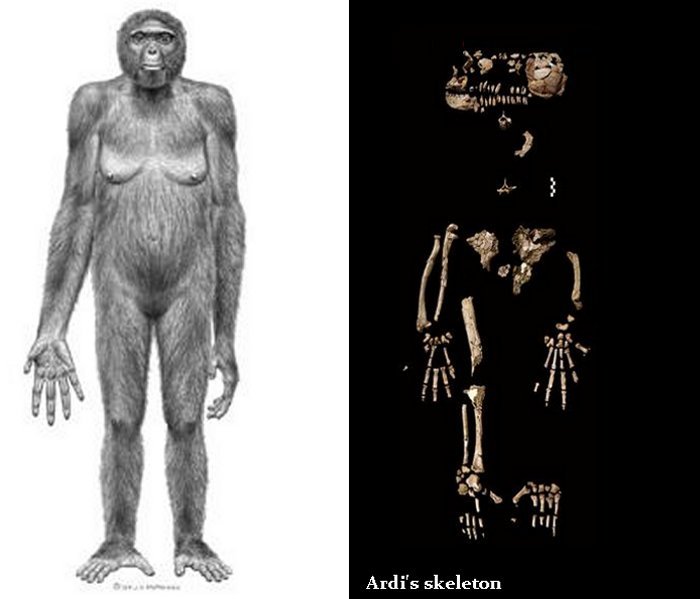A 4.4 Million-Year-Old Hand Of ‘Ardi’ Has Some Clues On Humans’ Upright Walking
Conny Waters – MessageToEagle.com – Early 20th-century anatomical research supported the view that humans evolved from a suspensory ancestor bearing some resemblance to apes.
Charles Darwin and others recognized a close evolutionary relationship between humans, chimps, and gorillas based on their shared anatomies, raising some big questions: how are humans related to other primates, and exactly how did early humans move around?
Left: Scientific paleoartist Jay Matternes’ rendition of Ardi. source; Right: The recovered fragments of Ardi’s skeleton. source:
Researchers examined the skeletal remains of Ardipithecus ramidus (“Ardi”), dated to 4.4 million years old and found in Ethiopia.
The Ardi skeleton was discovered at Aramis in the arid badlands near the Awash River in Ethiopia in 1994 . Ardi weighed about 50 kg (110 lb), and could be up to 120 cm (3.9 ft) tall. Although she is a biped, Ardi had both opposable big toes and thumbs in order to climb trees. It is speculated that her bipedality impeded movement, but enabled her to bear more offspring.
Although it is not known whether Ardi’s species is related to Homo sapiens, the discovery is of great significance and has been long debated.
Ardi is unique because she possesses traits that are characteristic of both extinct primates and early hominids. It is still a point of debate whether Ardi was capable of bipedal movement.
Ardi’s divergent big toes are not characteristic of a biped. However, the remains of her legs,
feet, pelvis, and hands suggested that she walked upright when on the ground but was a quadruped
when moving around trees.
One of Ardi’s hands was exceptionally well-preserved.
The researchers compared the shape of Ardi’s hand to hundreds of other hand specimens representing recent humans, apes and monkeys (measured from bones in museum collections around the world) to make comparisons about the kind of locomotor behavior used by the earliest hominins (fossil human relatives).
The results provide clues about how early humans began to walk upright and make similar movements that all humans perform today.
Left: Scientific paleoartist Jay Matternes’ rendition of Ardi. source; Right: The recovered fragments of Ardi’s skeleton. source:
“Bone shape reflects adaptation to particular habits or lifestyles – for example, the movement of primates – and by drawing connections between bone shape and behavior among living forms, we can make inferences about the behavior of extinct species, such as Ardi, that we can’t directly observe,” Thomas Cody Prang, assistant professor of anthropology from Texas A&M University said.
“Additionally, we found evidence for a big evolutionary ‘jump’ between the kind of hand represented by Ardi and all later hominin hands, including that of Lucy’s species (a famous 3.2 million-year-old well-preserved skeleton found in the same area in the 1970s). This ‘evolutionary jump’ happens at a critical time when hominins are evolving adaptations to a more human-like form of upright walking, and the earliest evidence for hominin stone-tool manufacture and stone-tool use, such as cut-marks on animal fossils, are discovered.”
Prang said the fact that Ardi represents an earlier phase of human evolutionary history is important because it potentially shines a light on the kind of ancestor from which humans and chimpanzees evolved.
“Our study supports a classic idea first proposed by Charles Darwin in 1871, when he had no fossils or understanding of genetics, that the use of the hands and upper limbs for manipulation appeared in early human relatives in connection with upright walking,” he said. “The evolution of human hands and feet probably happened in a correlated fashion.”
Since Ardi is such an ancient species, it might retain skeletal features that were present in the last common ancestor of humans and chimpanzees. If this is true, it could help researchers place the origin of the human lineage – in addition to upright walking – into a clearer light.
See also:
Did An Ancient Supernova Force Humans To Walk Upright?
“It potentially brings us one step closer to an explanation for how and why humans evolved our form of upright walking,” Prang said.
He added that the big change in hand anatomy between Ardi and all later hominins occurs at a time, roughly between 4.4 and 3.3 million years ago, coinciding with the earliest evidence of the loss of a grasping big toe in human evolution. This also coincides with the earliest known stone tools and stone cut-marked animal fossils.
He said it appears to mark a major change in the lifestyle and behavior of human relatives within this timeframe.
“We propose that it involves the evolution of more advanced upright walking, which enabled human hands to be modified by the evolutionary process for enhanced manual manipulation, possibly involving stone tools,” Prang said.
Written by Conny Waters – MessageToEagle.com – AncientPages.com Staff Writer












